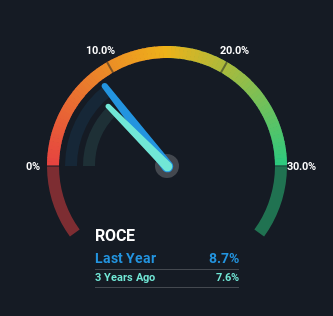Slowing Rates Of Return At Toyota Motor (TSE:7203) Leave Little Room For Excitement
If you're not sure where to start when looking for the next multi-bagger, there are a few key trends you should keep an eye out for. Firstly, we'd want to identify a growing return on capital employed (ROCE) and then alongside that, an ever-increasing base of capital employed. If you see this, it typically means it's a company with a great business model and plenty of profitable reinvestment opportunities. Having said that, from a first glance at Toyota Motor (TSE:7203) we aren't jumping out of our chairs at how returns are trending, but let's have a deeper look.
Understanding Return On Capital Employed (ROCE)
For those that aren't sure what ROCE is, it measures the amount of pre-tax profits a company can generate from the capital employed in its business. The formula for this calculation on Toyota Motor is:
Return on Capital Employed = Earnings Before Interest and Tax (EBIT) ÷ (Total Assets - Current Liabilities)
0.087 = JP¥5.5t ÷ (JP¥94t - JP¥30t) (Based on the trailing twelve months to June 2024).
Therefore, Toyota Motor has an ROCE of 8.7%. Ultimately, that's a low return and it under-performs the Auto industry average of 12%.
Check out our latest analysis for Toyota Motor

In the above chart we have measured Toyota Motor's prior ROCE against its prior performance, but the future is arguably more important. If you're interested, you can view the analysts predictions in our free analyst report for Toyota Motor .
The Trend Of ROCE
In terms of Toyota Motor's historical ROCE trend, it doesn't exactly demand attention. The company has consistently earned 8.7% for the last five years, and the capital employed within the business has risen 87% in that time. Given the company has increased the amount of capital employed, it appears the investments that have been made simply don't provide a high return on capital.
In Conclusion...
As we've seen above, Toyota Motor's returns on capital haven't increased but it is reinvesting in the business. Investors must think there's better things to come because the stock has knocked it out of the park, delivering a 101% gain to shareholders who have held over the last five years. Ultimately, if the underlying trends persist, we wouldn't hold our breath on it being a multi-bagger going forward.
Toyota Motor does come with some risks though, we found 3 warning signs in our investment analysis, and 2 of those make us uncomfortable...
While Toyota Motor isn't earning the highest return, check out this free list of companies that are earning high returns on equity with solid balance sheets.
Valuation is complex, but we're here to simplify it.
Discover if Toyota Motor might be undervalued or overvalued with our detailed analysis, featuring fair value estimates, potential risks, dividends, insider trades, and its financial condition.
Access Free AnalysisHave feedback on this article? Concerned about the content? Get in touch with us directly. Alternatively, email editorial-team (at) simplywallst.com.
This article by Simply Wall St is general in nature. We provide commentary based on historical data and analyst forecasts only using an unbiased methodology and our articles are not intended to be financial advice. It does not constitute a recommendation to buy or sell any stock, and does not take account of your objectives, or your financial situation. We aim to bring you long-term focused analysis driven by fundamental data. Note that our analysis may not factor in the latest price-sensitive company announcements or qualitative material. Simply Wall St has no position in any stocks mentioned.
About TSE:7203
Toyota Motor
Designs, manufactures, assembles, and sells passenger vehicles, minivans and commercial vehicles, and related parts and accessories in Japan, North America, Europe, Asia, Central and South America, Oceania, Africa, and the Middle East.
Adequate balance sheet average dividend payer.
Similar Companies
Market Insights
Community Narratives




